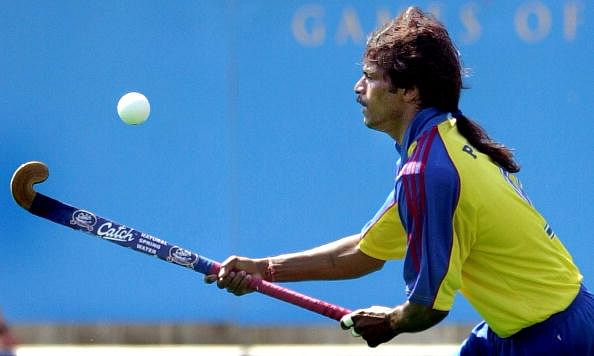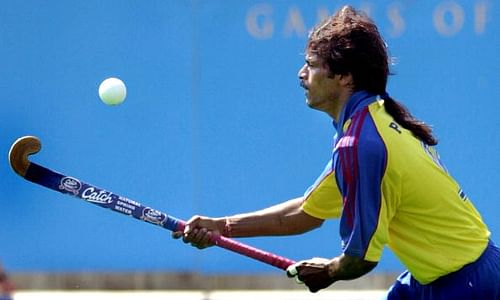
Book Review - Forgive me Amma – The Life and Times of Dhanraj Pillay!
“Amma, I have failed you, Amma. Three Olympics I have played and I couldn’t get a medal back… Amma, forgive me, I have failed”, says the blurb on the back page of “Forgive me Amma – The life and times of Dhanraj Pillay” by Sundeep Mishra, elucidating a rather extraordinary tale of a man who unfortunately belonged to the sorry state of Indian Hockey. The picture on the front page with head bowed down, shoulders dropped, holding the hockey stick in the left hand will nothing but make your heart weep. No second thoughts here, this forward in hockey is one of the most gifted players the world has ever seen, possibly the greatest in his hey-days, and the author of this book is one of the celebrated hockey writers of the nation. The author is one who has travelled immensely with the team, covering as many as five World Cups, two Olympics, ten Sultan Azlan Shah tournaments, and many a domestic event, and therefore is in the best position to talk about the legend. As a book, it will never for any moment disappoint an ardent hockey fan nor any voracious sports reader for it opens the game before the eyes in a rather poetic way.
The foreword by another of the game’s great, a doctor of medicine from Australia, Dr Richard Charlesworth tells in short about how devoted a player Dhanraj was and what hockey meant to him. It also unveils how Indian hockey declined when the rest climbed up the ladder and how an individual’s passion and pride in representing the country were never taken into consideration by the spoilt selection committee, that hardly respected a player for his performances on the field. This silver medalist at the 1976 Montreal Olympics in his book “The Coach”, names Dhanraj Pillay in the ‘best international team’. The other two Indians to have made to that list are Ajitpal Singh and Mohammad Shahid. The final sentence of the foreword reads “Of Dhanraj, all that is left to say is that he will be missed. The game is the lesser with your departure” clearly depicting the legendary picture of Dhanraj Pillay.
The forward in hockey is a responsible role and an advanced one, demanding the attentiveness of the player who will be positioned nearest to the opponent’s goal. It requires speed, accuracy and strength from the players enough to sense a scoring opportunity. A forward is one who would shift to the midfield and either of the wings depending upon the changing dynamics of the game. Not only did Dhanraj justify his position, but was also one who played with gumption, took the game to the opposition and never allowed them to settle down for even once in the entire game.
Balbir Singh Sr, a triple Olympic gold medalist, throws a question to readers asking to decide whether they want their wards to be crowd-pullers or medal-winners. Yes, Dhanraj did invite crowds in huge numbers whenever he took to field, but unfortunately, victories and medals on the international scene were not to be. As a player, Dhanraj was one who always took to the game with passion; one who considered the team’s failures and victories as his personal ones; one who played the game with nothing but pride and fervor.
Sundeep Mishra adapts a new style of writing, by dividing Dhanraj’s career into 19 brilliant chapters, starting with his birth and family, his ability early in the career to position himself perfectly upfront, showing immense control over the ball to grab the attention of selectors, tasting stardom at the 1995 SAF games, his performance at the 1998 Bangkok Asian games and describes many such ebbs and tides in his glorious career, before ending the book with a heart touching chapter “We all grow old”. In a celebrated career that spanned from December 1989 to August 2004, Dhanraj, who was initially more passion more than confidence, matured mentally enough to analyze his own game, came back stronger with every passing game and uplifted his team almost single handedly from the abyss on many an occasion.
The eleventh chapter “I don’t think I will ever get over it”, on the Sydney Olympics 2000, where Dhanraj, after the match against Poland, went into the hotel room and sobbed over the phone with his mother on the other side will make one notice what winning a medal for his nation meant for this great man. Sundeep used very simple language so that even the beginners could understand every sentence put forth in describing this legend. He brings to light a perfect picture of many international events that featured our hero. Also, Dhanraj’s uneasiness with the coaches and the Hockey Association has been written in a very decent, elegant and inoffensive manner by the author.
Sundeep’s book is highly rich about the man and his art in the battle field. Talking about his tackles, goals and moves on the field is a bit easy, but narrating those vital factors that went into the making of one of the greats of the game demands that extra bit of effort; Sundeep achieved it with grace. It’s no wonder that had a player of this stature represented any other nation like Australia, or Germany, they would have struck gold at almost every tournament that involved this man. He was under-appreciated by the Indian hockey federation, underrated by many; yet his unparalleled passion for the game saw him represent India with pride.
In the course of bringing the life of Dhanraj into black and white, the author quotes about this great man in an awe-inspiring way on two occasions as follows:
“Watching Dhanraj play was magical, it tells us a story so personal, so universal – the story of one man’s pride and passion being humbled by the whim and fancy of the gods”.
“Will any kid or someone brought up on diet of television induced cricket would ever recognize a player of the stature Dhanraj Pillay? No one could ever play for India with the kind of passion and attention Dhanraj displayed”.
Of all, in a rather short volume that accounts for 395 rupees, Sundeep Mishra has written a perfect hockey biography – incontrovertible, close to reality, adorned by several pieces of enlightenment. A worthwhile addition to a rich tapestry in Hockey’s literature.
